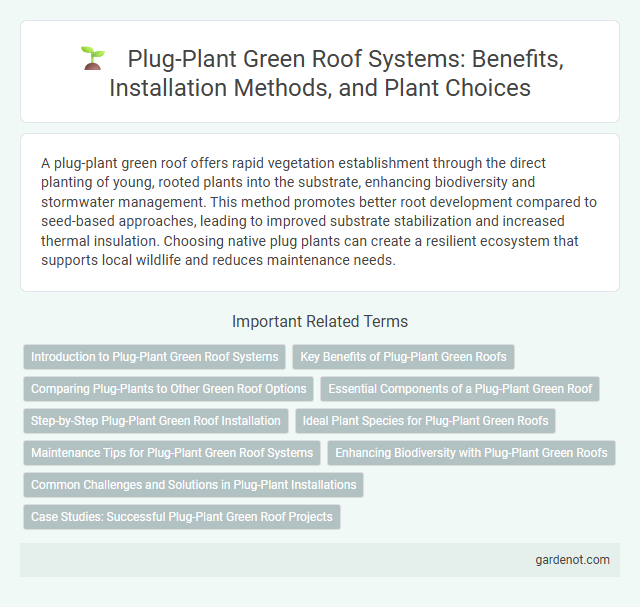A plug-plant green roof offers rapid vegetation establishment through the direct planting of young, rooted plants into the substrate, enhancing biodiversity and stormwater management. This method promotes better root development compared to seed-based approaches, leading to improved substrate stabilization and increased thermal insulation. Choosing native plug plants can create a resilient ecosystem that supports local wildlife and reduces maintenance needs.
Introduction to Plug-Plant Green Roof Systems
Plug-plant green roof systems utilize young, individually grown plants that are transplanted onto the substrate to promote rapid vegetation establishment and increased biodiversity. These systems offer enhanced root development and better adaptability to varying microclimates compared to traditional seed-based green roofs. Ideal for extensive and semi-intensive applications, plug-plant green roofs provide efficient erosion control and improve stormwater management while supporting urban ecological benefits.
Key Benefits of Plug-Plant Green Roofs
Plug-plant green roofs offer rapid establishment and enhanced plant survival due to the use of mature seedlings grown in controlled environments. These systems improve stormwater management by increasing water retention and reducing runoff, contributing to urban flood mitigation. The dense vegetation cover also enhances insulation, reducing energy consumption for heating and cooling in buildings.
Comparing Plug-Plants to Other Green Roof Options
Plug-plant green roofs offer faster establishment and increased biodiversity compared to traditional sedum mats due to their use of young plants that adapt quickly to local conditions. Unlike pre-vegetated mats, plug plants allow for more diverse species selection, promoting better resilience to environmental stresses and enhancing habitat value. This approach also supports tailored vegetation patterns that optimize aesthetics and ecological benefits on green roof installations.
Essential Components of a Plug-Plant Green Roof
A plug-plant green roof consists of a waterproof membrane, a root barrier, and a lightweight growing medium designed for efficient drainage and aeration. Vegetation plugs, typically sedums or native plants, are carefully selected for their drought tolerance and minimal maintenance needs. Integrated irrigation systems and drainage layers ensure optimal water retention and prevent root saturation, promoting healthy plant growth and long-term roof durability.
Step-by-Step Plug-Plant Green Roof Installation
Step-by-step plug-plant green roof installation begins with selecting drought-tolerant succulent plugs that ensure vibrant coverage and minimal maintenance. Next, a lightweight growing medium is evenly spread over a waterproof roof membrane to promote healthy root development and drainage. Finally, plugs are carefully planted with proper spacing to maximize growth, followed by regular watering to establish strong root systems and long-term sustainability.
Ideal Plant Species for Plug-Plant Green Roofs
Ideal plant species for plug-plant green roofs include Sedum varieties, drought-tolerant succulents, and native wildflowers known for their resilience and low maintenance requirements. These plants thrive in shallow substrate depths, tolerate extreme weather, and promote biodiversity while enhancing stormwater management. Selecting species with deep root systems and high evapotranspiration rates optimizes green roof performance and longevity.
Maintenance Tips for Plug-Plant Green Roof Systems
Regular irrigation and targeted weeding are essential maintenance tips for plug-plant green roof systems to promote healthy plant establishment. Periodic inspections ensure proper drainage and prevent structural strain caused by water accumulation. Supplementing nutrients through slow-release fertilizers supports robust growth and longevity of the vegetation.
Enhancing Biodiversity with Plug-Plant Green Roofs
Plug-plant green roofs significantly enhance urban biodiversity by incorporating diverse, native plant species that offer habitat and food sources for pollinators and other wildlife. Their modular planting method ensures rapid establishment, increasing ecological resilience and supporting local ecosystems. Research shows that plug-plant green roofs can boost species richness by up to 40% compared to traditional extensive green roofs.
Common Challenges and Solutions in Plug-Plant Installations
Plug-plant green roofs often face common challenges such as poor root establishment, uneven plant growth, and water retention issues due to inconsistent substrate conditions. Solutions include selecting drought-tolerant plug varieties, ensuring uniform substrate depth, and implementing precise irrigation systems to enhance survival rates and promote healthy, uniform coverage. Regular maintenance and monitoring also help address pest infestations and nutrient deficiencies, improving overall plug-plant green roof performance.
Case Studies: Successful Plug-Plant Green Roof Projects
Successful plug-plant green roof projects demonstrate significant environmental benefits, including enhanced stormwater management and improved urban biodiversity. Case studies from urban centers like Toronto and Berlin highlight rapid vegetation establishment and reduced maintenance costs using native plug plants. These projects showcase scalable solutions for sustainable urban development through effective plug-plant implementation.
Plug-plant green roof Infographic

 gardenot.com
gardenot.com